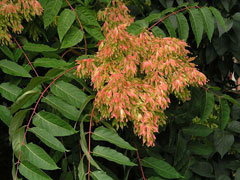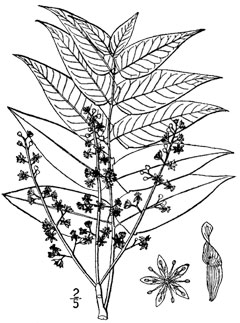 |
|
http://commons.wikimedia.org/wiki/User:Luis_Fernández_García |
 |
|
Translate this page:
Summary
Bloom Color: Green.
Main Bloom Time: Early spring, Late spring, Mid spring. Form: Upright or erect, Vase.
Physical Characteristics

 Ailanthus altissima is a deciduous Tree growing to 25 m (82ft) by 15 m (49ft) at a fast rate.
Ailanthus altissima is a deciduous Tree growing to 25 m (82ft) by 15 m (49ft) at a fast rate.
See above for USDA hardiness. It is hardy to UK zone 7. It is in flower from July to August, and the seeds ripen from September to November. The species is dioecious (individual flowers are either male or female, but only one sex is to be found on any one plant so both male and female plants must be grown if seed is required). and is pollinated by Bees. The plant is not self-fertile.
Suitable for: light (sandy) and medium (loamy) soils and can grow in nutritionally poor soil. Suitable pH: mildly acid, neutral and basic (mildly alkaline) soils. It can grow in semi-shade (light woodland) or no shade. It prefers dry moist or wet soil and can tolerate drought. The plant is not wind tolerant.
It can tolerate atmospheric pollution.
UK Hardiness Map
US Hardiness Map
Synonyms
A. glandulosa. Toxicodendron altissimum.
Plant Habitats
Woodland Garden Canopy; Hedge; Bog Garden;
Edible Uses
Edible Parts: Leaves
Edible Uses:
Leaves - cooked[105]. Used as an emergency food in times of scarcity, they have an offensive odour[2, 177, 178]. Some caution is advised, see the notes above on toxicity.
References More on Edible Uses
Medicinal Uses
Plants For A Future can not take any responsibility for any adverse effects from the use of plants. Always seek advice from a professional before using a plant medicinally.
Anthelmintic Antibacterial Anticonvulsant Antidiarrhoeal Antispasmodic Astringent Bitter Cardiac
Deobstruent Diuretic Dysentery Emetic Emmenagogue Epilepsy Febrifuge
Malaria Rubefacient
The tree of heaven is not often used in Western herbal medicine, though it is more popular in the Orient. Various parts of the plant are used, though the bark is the part most commonly used - however, it contains a glycoside that has not been fully researched and so should be used with caution[7]. The root and stem bark are antispasmodic, astringent, bitter, cardiac depressant, diuretic, emetic, febrifuge, rubefacient and vermifuge[4, 61, 147, 176, 178, 218, 238]. The vermifuge properties do not act on round worms or earthworms[269]. A nauseatingly bitter herb, it is used internally to treat malaria and fevers, it also slows the heart rate and relaxes spasms[238]. It needs to be used under the supervision of a qualified practitioner since the bark readily causes vomiting[238]. In China, the bark is a popular remedy for dysentery and other complaints of the bowels[4]. In one clinical trial, 81 out of 82 patients were cured of dysentery when they were given this herb[254]. A tincture of the root-bark has been used successfully in the treatment of cardiac palpitations, asthma and epilepsy[4]. Tree-of-heaven is a folk remedy for asthma, cancer, diarrhoea, dysentery, dysmenorrhoea, dysuria, ejaculation (premature), epilepsy, eruption, fever, gonorrhoea, haematochezia, leucorrhoea, malaria, metrorrhagia, sores, spasms, spermatorrhoea, stomachic, tumours of the breast (China), and wet dreams[269] The bark is harvested in the spring and dried for later use[7]. The leaves, bark of the trunk, and roots are put into a wash to treat parasitic ulcers, itch, and eruptions[269]. In Korea, the root bark is used in the treatment of coughs, gastric and intestinal upsets[269]. The stembark is emmenagogue[218]. The leaves are anthelmintic, astringent and deobstruent[218]. The fruit is used in the treatment of bloody stools and dysentery[218, 269]. They have also been used to treat ophthalmic diseases[269]. Extracts from the plant are bactericidal[218]. The tree is used in homeopathic remedies for cancer[269]. A resin extracted from the roots and leaves is a revulsive or vesicant[269].
References More on Medicinal Uses
The Bookshop: Edible Plant Books
Our Latest books on Perennial Plants For Food Forests and Permaculture Gardens in paperback or digital formats.

Edible Tropical Plants
Food Forest Plants for Hotter Conditions: 250+ Plants For Tropical Food Forests & Permaculture Gardens.
More

Edible Temperate Plants
Plants for Your Food Forest: 500 Plants for Temperate Food Forests & Permaculture Gardens.
More

More Books
PFAF have eight books available in paperback and digital formats. Browse the shop for more information.
Shop Now
Other Uses
Dye Hedge Hedge Herbicide Insecticide Repellent Soil reclamation Soil stabilization Tannin Wood
A yellow dye is obtained from the leaves[7]. The leaves contain 12% tannin, quercetin, as well as isoquercetin, and the alkaloid linuthine[218, 269]. The leaves and wood are high in cellulose and are used in paper-making[7, 74]. The crushed leaves and flowers are insect-repellent[14]. The plant parts, when steeped in water, are said to yield an insecticidal solution[218, 269]. An aqueous extract of the leaves contains a substance that is toxic to other tree seedlings[240]. When plants are put into marshy areas they drain the soil and thereby remove mosquito breeding sites[254]. The plants have extensive root systems and sucker freely, they can be used in soil-stabilization programmes[149]. Since the plant is tolerant of soil pollution it can also be used in land reclamation schemes on old mine tips etc[200]. Plants can be grown as a tall hedge[14]. Wood - fairly hard, heavy, difficult to split, not durable, coarse grained. Though little used, except in poorer countries, the wood is suitable for cabinetry, cellulose manufacture, furniture, lumber, pulp, and woodwork. It is difficult to split but easy to work and polish. The wood is also used locally for charcoal and firewood[4, 46, 149, 178, 269]. Yields of 20 cubic metres per hectare is possible for this light wood[269].
Special Uses
Hedge Hedge Scented Plants
References More on Other Uses
Cultivation details
Landscape Uses:Pest tolerant, Aggressive surface roots possible. A very tough and easily grown tree, succeeding under most conditions, the Tree of Heaven is resistant to most diseases and is also reported to be tolerant of alkalinity, drought, frost, heat, high pH, hydrogen fluoride, low pH, pollution, SO2, poor, dry or wet soils, heavily polluted soils and industrial pollution[200, 269]. The plant prefers a light moist soil and a sheltered position[1, 133]. Prefers a position in full sun or partial shade[238]. The tree is estimated to tolerate an annual precipitation of 30 to 250cm (tolerating a dry season up to 8 months), an annual average temperature of 10° to 20°C, and a pH of 5.5 to 8.0. Growing on the smallest of city plots and rubbish heaps, this species obviously can tolerate a wide array of soils, from acid to alkaline, sand to light clay, well-drained to swampy, poor to rich. It is said to do poorly on chalky soils or compact clay[269]. Plants are hardy to at least -15°c[200]. A very ornamental tree, it has a somewhat tropical appearance and is fast growing when young[1, 7, 14], though it is rather short-lived[229]. The trees send up suckers freely and soon form dense thickets[7, 200, 229]. The plant has become a noxious weed in parts of Australia and is rather weed-like in many other countries[238, 269]. The roots are rather aggressive and can cause damage to drainage systems[226]. The plants thrive even when growing in very polluted cities[11, 229] and so have been used as street trees and as shade-trees in parks[268], they do not do well in the north of Britain, however[98]. Male flowers are malodorous and have potentially allergenic pollen[80, 200]. The crushed leaves are also malodorous[226]. The large leaves have glandular teeth near their base and these release a pungent aroma when pressed[245]. The disagreeable odour of the plant may cause some people to feel sleepy[269]. This tree is occasionally cultivated for its wood[149]. This is brittle however, and branches are very liable to break off in the wind[200]. Trees coppice readily[200]. The leaves were once used as a food for silkworms[2], but were found to be unsuitable[7]. This species is notably resistant to honey fungus[88, 200]. Dioecious. Male and female plants must be grown if seed is required[269]. Special Features:Not North American native, Invasive, Attractive flowers or blooms.
References Carbon Farming Information and Carbon Sequestration Information
Temperature Converter
Type a value in the Celsius field to convert the value to Fahrenheit:
Fahrenheit:
The PFAF Bookshop
Plants For A Future have a number of books available in paperback and digital form. Book titles include Edible Plants, Edible Perennials, Edible Trees,Edible Shrubs, Woodland Gardening, and Temperate Food Forest Plants. Our new book is Food Forest Plants For Hotter Conditions (Tropical and Sub-Tropical).
Shop Now
Plant Propagation
Seed - best sown outdoors as soon as it is ripe[78]. If you only have a small quantity of seed it will probably be better to sow it in a cold frame. The germination can be poor[80], averaging about 56%[98], though one kilo of seed will normally produce in the region of 6,500 usable plants[269]. The seed germinates best if given a short cold stratification of 8 weeks[80, 113]. The seed is not usually produced in Britain[80]. Prick out the seedlings into individual pots when they are large enough to handle, keep them in a cold frame for their first winter and plant them out in late spring[K]. Root cuttings in December[113]. Suckers, planted out in late winter.
Other Names
If available other names are mentioned here
Native Plant Search
Search over 900 plants ideal for food forests and permaculture gardens. Filter to search native plants to your area. The plants selected are the plants in our book 'Plants For Your Food Forest: 500 Plants for Temperate Food Forests and Permaculture Gardens, as well as plants chosen for our forthcoming related books for Tropical/Hot Wet Climates and Mediterranean/Hot Dry Climates. Native Plant Search
Found In
Countries where the plant has been found are listed here if the information is available
Weed Potential
Right plant wrong place. We are currently updating this section.
Please note that a plant may be invasive in one area but may not in your area so it’s worth checking.
This plant can be weedy or invasive in Connecticut
(tree of heaven) - Invasive, banned. Massachusetts
(tree of heaven)- Prohibited. New Hampshire (tree of heaven) - Prohibited invasive Species.
Vermont (tree of heaven) - Class B noxious weed.
Moderat
Conservation Status
IUCN Red List of Threatened Plants Status : This taxon has not yet been assessed.

Growth: S = slow M = medium F = fast. Soil: L = light (sandy) M = medium H = heavy (clay). pH: A = acid N = neutral B = basic (alkaline). Shade: F = full shade S = semi-shade N = no shade. Moisture: D = dry M = Moist We = wet Wa = water.

Expert comment
Author
(Mill.)Swingle.
Botanical References
11200
Links / References
For a list of references used on this page please go here
Readers comment